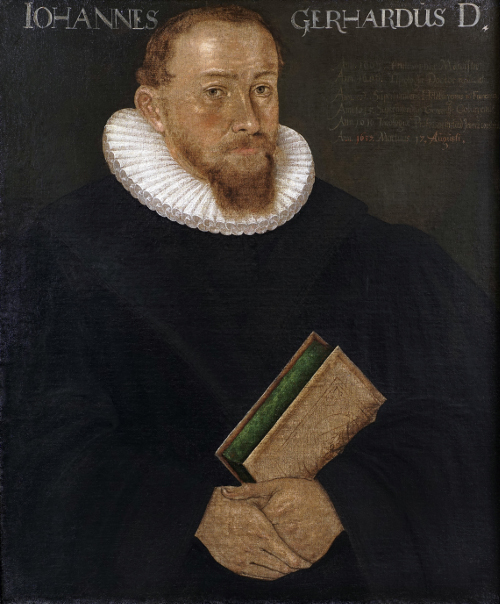A Leading Lutheran

Considered by many to hold third place among the greatest figures of early Lutheranism after Martin Luther and Martin Chemnitz, St. Johann Gerhard was a leading theologian of Lutheranism and pivotal figure of the sixteenth- and seventeenth-century Church. Much of his work built on that of Luther, Chemnitz, and Melanchthon, and his in-depth rendering of systematic theology has been treasured by both early and modern-day Lutherans.
Born on October 17, 1582, in Quedlinburg, Gerhard lived a typical life for a sixteenth-century German. He was one of seven children and became deathly ill in his teenage years. Through the counsel of his own pastor, Johann Arndt (the father of Lutheran Pietism), Gerhard took a special interest in theology. He vowed that if the Lord would grant him recovery, he would study to become a pastor and devote himself to understanding the Bible.
Even though Gerhard did in fact recover and go into the ministry, he faced illness time and time again throughout his life. In 1598 he became sick from the plague. In 1603 an illness caused him to become so worried about his impending death that he wrote his last will. There were even more times of critical illness throughout the remainder of his time on earth.
His challenges did not end there. He graduated from seminary in 1605 and in 1608 married Barbara Nuemeye, who died just five years later following the death of the one child she and Gerhard had together. He wrote one of his most well known works, Handbook of Consolations for the Fears and Trials that Oppress Us in the Struggle with Death, during that time. Yet Gerhard found companionship again, remarrying Maria Mattenberg in 1614. She gave him ten children, and they were married twenty-three years.
After his initial time studying theology in Wittenberg and Jena, Gerhard found that he was drawn to academia. He first served as a superintendent of Heldburg and was then appointed to look after the entire duchy. Later, from 1616 onward, the saint served as a professor at the University in Jena, where he had previously studied. It was there that he sought to organize his love and understanding of Scriptures in a way that would be easy to communicate to others and that would systematically make sense to his students. He wrote many apologetic works against Roman Catholicism and Unitarianism, seeking to solidify Lutherans’ understandings of their doctrine in the decades after the Reformation.
With the beginning of the Thirty Years’ War in 1618, Gerhard was often asked for advice regarding the war. This significant event also influenced his views on theology. During the war Gerhard was assaulted and threatened numerous times for his religious beliefs. Even so, he never stopped his work, continuing on with his revision of the German translation of the Bible and other personal writings. He and his work grew quite popular, and he came to be regarded as the greatest living theologian of Protestant Germany. Almost every university in Germany asked him to come teach for them, but he stayed in Jena.
In 1637, Gerhard became sick once more, overtaken by a high fever. He died on August 17th. His last words are remembered to have been, “Come, come, Lord, come.”
Brief History
When one looks at the whole of Gerhard’s life and his influence on the Lutheran Church, he might take notice of how some of his most significant works shaped the trajectory of the faith. For example, his massive Loci communes theologici sought to trace the roots of theological doctrine in Scripture and detailed the ways in which the Church adopted its theological traditions. This opus ended up being twenty-two volumes long and is still heralded today as one of the best articulations of the Lutheran Church’s beliefs.

Similarly, Gerhard’s devotional works such as his Sacred Meditations, Meditations on Divine Mercy, and the aforementioned Handbook of Consolations have stood the test of time as gems of Lutheranism. These are works that are meant to be used in the daily lives of ordinary believers. Many especially love the way in which Gerhard quotes both Scripture and the Church fathers together in his writings, creating explicit connections between the ways in which Church history and tradition further Biblical beliefs.
In summary, this saint has been long seen as a great professor, teacher, and pastor of the Church—a man who always sought God in every trial and difficulty that he faced. As members of the Lutheran Church, we still look up to him today, holding August 17th as a time to remember for his faithful witness and confession.
Collect
O God, Who didst give Blessed Johann to Thy people as a minister of eternal salvation: grant, we beseech Thee, that we, who have had him for our teacher on earth, may with him enjoy Thine eternal glories; through Jesus Christ our Lord, who liveth and reigneth with Thee and the Holy Ghost: ever one God, world without end. Amen.
Lessons
Resources
Issues, Etc. interview with the Rev. Dr. Bill Mayes on the Eternal Life and Lutheran Theologian Johann Gerhard
Issues, Etc. interview with Dr. Jack Kilcrease on 17th Century Lutheran Theologian Johann Gerhard
Issues, Etc. interview with the Rev. Dr. Glenn Fluegge on 17th Century Lutheran Theologian Johann Gerhard
Propers found in Daily Divine Service Book: A Lutheran Daily Missal, edited by the Rev. Heath Curtis
References:
1. Weedon, William. Celebrating the Saints. Concordia Publishing House. 2016.
2. Carr, Simonetta. “Johann Gerhard—Pastor and Teacher in Troubling Times.” 2021.
Images:
1. Copper Engraving of Johann Gerhard (1582-1637), Uknnown, Germany, 17th Century.
2. Portrait of Johann Gerhard, Unknown, Germany, 1618.



